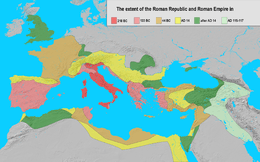44 BC
| Millennium: | 1st millennium BC |
|---|---|
| Centuries: | 2nd century BC – 1st century BC – 1st century |
| Decades: | 70s BC 60s BC 50s BC – 40s BC – 30s BC 20s BC 10s BC |
| Years: | 47 BC 46 BC 45 BC – 44 BC – 43 BC 42 BC 41 BC |
| 44 BC by topic |
| Politics |
|---|
|
| Categories |
|
| Gregorian calendar | 44 BC |
| Ab urbe condita | 710 |
| Ancient Egypt era | XXXIII dynasty, 280 |
| - Pharaoh | Cleopatra VII, 8 |
| Ancient Greek era | 184th Olympiad (victor)¹ |
| Assyrian calendar | 4707 |
| Bengali calendar | −636 |
| Berber calendar | 907 |
| Buddhist calendar | 501 |
| Burmese calendar | −681 |
| Byzantine calendar | 5465–5466 |
| Chinese calendar | 丙子年 (Fire Rat) 2653 or 2593 — to — 丁丑年 (Fire Ox) 2654 or 2594 |
| Coptic calendar | −327 – −326 |
| Discordian calendar | 1123 |
| Ethiopian calendar | −51 – −50 |
| Hebrew calendar | 3717–3718 |
| Hindu calendars | |
| - Vikram Samvat | 13–14 |
| - Shaka Samvat | N/A |
| - Kali Yuga | 3058–3059 |
| Holocene calendar | 9957 |
| Iranian calendar | 665 BP – 664 BP |
| Islamic calendar | 685 BH – 684 BH |
| Julian calendar | 44 BC |
| Korean calendar | 2290 |
| Minguo calendar | 1955 before ROC 民前1955年 |
| Seleucid era | 268/269 AG |
| Thai solar calendar | 499–500 |
| Wikimedia Commons has media related to 44 BC. |

The Roman empire in 44 BC (in dark and light red and orange)
Year 44 BC was either a common year starting on Sunday or Monday or a leap year starting on Friday or Saturday (link will display the full calendar) of the Julian calendar (the sources differ, see leap year error for further information) and a common year starting on Sunday of the Proleptic Julian calendar. At the time, it was known as the Year of the Consulship of Caesar and Antony (or, less frequently, year 710 Ab urbe condita). The denomination 44 BC for this year has been used since the early medieval period, when the Anno Domini calendar era became the prevalent method in Europe for naming years.
Events
By place
Roman Republic
- Consuls: Gaius Julius Caesar (death), Mark Antony.
- February – Rome celebrates the festival of the Lupercal. Mark Antony presents Caesar with a royal diadem, urging him to take it and declare himself king. He refuses this offer and orders the crown to be placed in the Temple of Jupiter.
- March 15 (the Ides of March) – Julius Caesar, dictator of Rome, is assassinated by a group of senators, amongst them Gaius Cassius Longinus, Marcus Junius Brutus, and Caesar's Massilian naval commander, Decimus Brutus.
- March 20 – Caesar's funeral is held. Marcus Antony gives a eulogy and in his Friends, Romans, countrymen, lend me your ears speech he makes accusations of murder and ensures a permanent breach with the conspirators against Caesar. He snatches Caesar's purple toga to show the crowd the stab wounds, the citizens tear apart the forum and cremate their Caesar on a makeshift pyre. Antony becomes the first man in Rome.
- April – Octavian returns from Apollonia in Dalmatia to Rome to take up Caesar's inheritance, against advice from Atia (his mother and Caesar's niece) and consular stepfather Antony.
- April 18–April 21 – Octavian engages in a charm offensive with consular Cicero who is fulminating against Mark Antony.
- June – Antony is granted a five-year governorship of northern and central Transalpine Gaul (France) and Cisalpine Gaul (Northern Italy).
- September 2
- Pharaoh Cleopatra VII of Egypt declares her son co-ruler as Ptolemy XV Caesarion.
- The first of Cicero's Philippics (oratorical attacks) on Antony is published. He will make 14 of them over the next several months.
- December – Antony besieges Brutus Albinus in Mutina (Modena), with Octavian, an ally of Decimus, who is one of his uncle's assassins, close by.
- A Denarius with a portrait of Julius Caesar is made. It is now kept at the American Numismatic Society in New York.
Europe
Births
- Gnaeus Calpurnius Piso, Roman statesman and governor of Syria (d. 20 AD)
Deaths
- March 15 – Julius Caesar, assassinated in the Senate (b. 100 BC)
- July 26 – Pharaoh Ptolemy XIV of Egypt (last date mentioned alive) (b. 60 BC/59 BC)
- Burebista, King of Dacia (ruled 82 BC–44 BC)